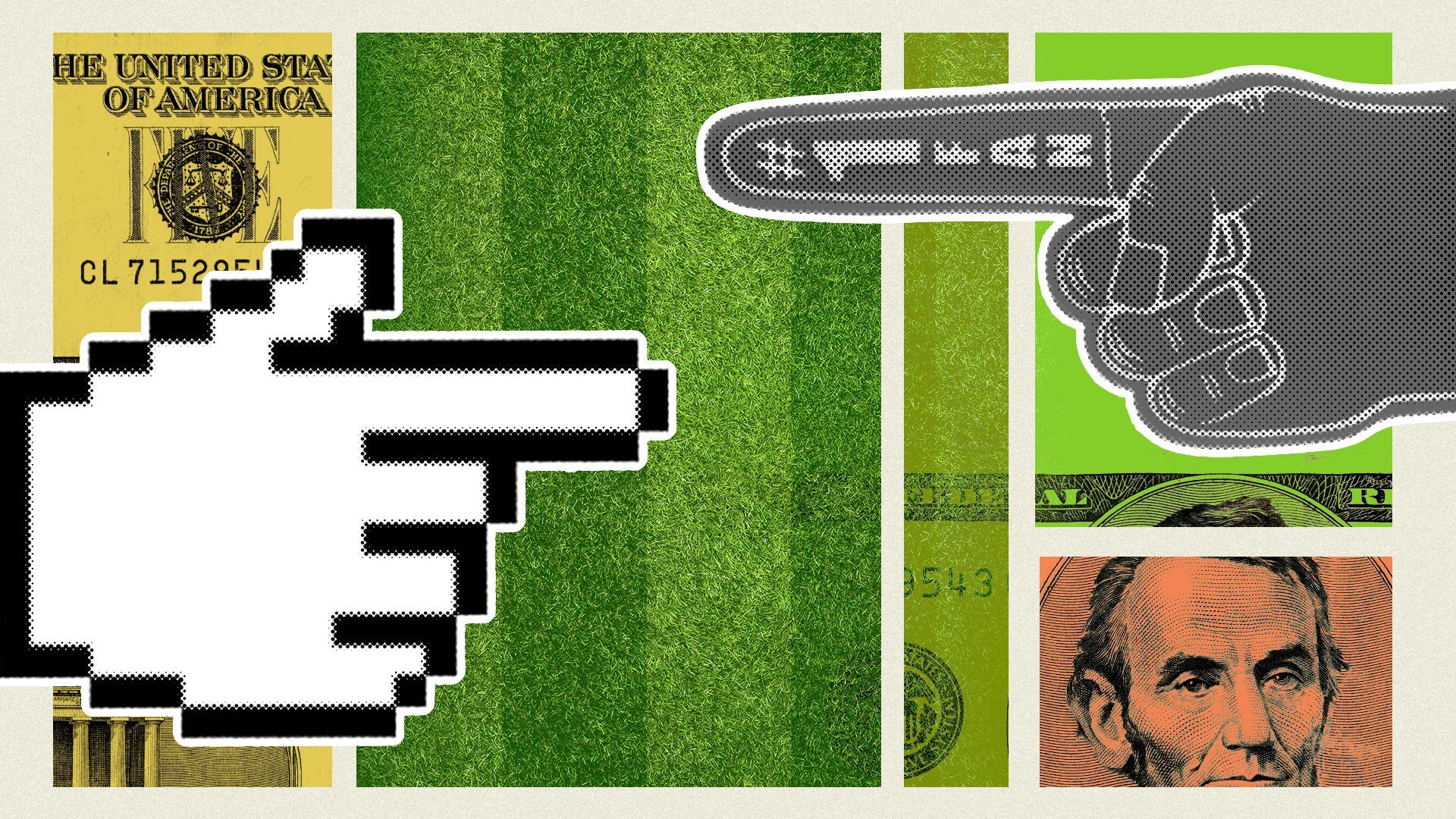| | | | | | | Presented By Cooley | | | | Axios Pro Rata | | By Kia Kokalitcheva · Aug 20, 2022 | | Welcome back to the weekend edition! - This week, we're talking about sports and media, as reported by my colleagues Tim Baysinger, Kerry Flynn, and Sara Fischer, and edited by Axios Pro's George Moriarty.
- 📪 Try out Axios Pro and get $200 off any Axios Pro subscription by using code PRO200 at checkout.
Today's newsletter is 1,323 words - 5 minutes. | | | | | | 1 big thing: Big tech crashes big sports |  | | | Illustration: Shoshana Gordon/Axios | | | | After years of watching traditional media dominate live sports, tech giants have decided it's time to get in the game by paying up for live sports rights, writes Axios Pro's Tim Baysinger. Why it matters: The value of sports rights has been in the stratosphere, and the inclusion of trillion-dollar tech giants will only lift those numbers higher. State of play: Disney, Comcast, Paramount, and Fox will pay a combined $24.2 billion for sports rights in 2024 alone, according to data from MoffettNathanson. - Apple has quickly established itself as a major player for sports rights with deals for Major League Baseball and Major League Soccer that could end up totaling more than $3 billion.
- Amazon has a sports empire of its own with regional deals for U.S. teams, including the New York Yankees through a minority stake in New York RSN YES Network, as part of a $3.47 billion deal.
- It also holds regional rights for a number of leagues in Europe.
- And Amazon bought the rights to NFL's "Thursday Night Football" franchise for $1 billion a year through 2023.
Yes, and: Apple and Amazon are battling for the NFL's Sunday Ticket package — a deal that is expected to include a stake in the league's media business — with Apple seen as the heavy favorite. But, but, but... Most of the sports rights still reside with the established media giants that now have their own streaming services. Between the lines: Traditional media companies love sports because they drive huge viewership that turns into big ad dollars. Big tech has a different goal. - Apple and Amazon are more concerned with their ability to attract new subscribers that they can convert to higher-margin parts of their business.
- "I'm sure [Amazon has] algorithms that show how many people who subscribe to the NFL will turn around and buy music or buy merchandise," Lee Berke, CEO of LHB Sports, told Axios. "So that gives you a totally different perspective."
What's next: The NBA's upcoming rights renewal will be closely watched next year. - Its current deal runs through the 2024-25 season, but it's attractive for the younger audience compared to the other sports and has a reputation for forward-thinking under Commissioner Adam Silver.
- "When it comes to the NBA ... they're not going to ignore broadcast or cable, but there's going to be a range of content offered up in a range of platforms," Berke says.
Go deeper. |     | | | | | | 2. TV money is breaking college sports |  | | | Illustration: Sarah Grillo/Axios | | | | The upheaval going on in college sports that has seen multiple major schools switch conference allegiances is being driven almost entirely by a lust for TV dollars, reports Tim. Why it matters: The gulf between the haves and the have-nots created by the ocean of money in college sports is only going to get wider. Driving the news: USC and UCLA will join the Big Ten Conference starting in 2024, making it the first conference to span both coasts. In 2025, Texas and Oklahoma will decamp from the Big 12 for the SEC. - These moves are done to increase the payouts to schools. USC and UCLA stand to make an additional $40 million a year, thanks to the Big Ten's new $7 billion rights deal announced this week.
- It will be the first conference to eclipse $1 billion annually in media rights revenue.
- The moves triggered a domino effect of smaller schools moving up the ladder. Last year, 24 schools switched conferences.
The big picture: Live sports valuations keep skyrocketing as sports, particularly football, offer the last pillar of the legacy cable model. - Two other factors unique to college sports: Each conference acts as its own separate entity, and media giants such as Fox and Disney have financial stakes in the long-term health of those conferences.
- "Because of this fragmented marketplace, individual entities can use that to their advantage to advantage themselves, which may or may not be in the best long-term interest of college sports," Bruin Sports Capital CEO George Pyne told Axios.
The intrigue: The Big 12 even publicly accused ESPN — one of its own biggest rights partners — of meddling to convince Big 12 schools to leave. Yes, and: "This has huge ramifications to the college ecosystem, which really aren't being taken into consideration," said Pyne. "It does really become a survival of the fittest and every man for himself." Go deeper. |     | | | | | | 3. Regional sports networks bet on direct-to-consumer streaming |  Data: S&P Global Market Intelligence; Chart: Axios Visuals Boston calls itself the Hub of the World, and the New England Sports Network is paving the future for sports fans as the first regional sports network to launch a direct-to-consumer streaming service. Many more are coming, writes Axios Pro's Kerry Flynn. Why it matters: Live sports is one of the few remaining reasons for cable, and yet regional sports network subscribers are dwindling, per S&P Global Market Intelligence's Kagan. State of play: As cord-cutting has left streaming services fighting for consumers' wallets, a sports fan can now subscribe to their team's streamer. What's happening: NESN 360 launched in June at $29.99 monthly or $329.99 annually, including live games, video-on-demand content, and perks such as free Red Sox tickets. - Game streams are up 40% month-over-month since the launch and on average 40% of subscribers watch any given Red Sox game.
- "People are looking for more choice and more access to the things they care about most," says NESN CMO Ahmed Darwish. "We want to make sure that we're building something that people love."
Yes, and: Sinclair Broadcast Group's Bally Sports operates in 19 markets, and released its RSN app, Bally Sports+, to five of those in June and 19 more next month. - "There is significant fandom that is outside the pay-TV bundle. Servicing those fans is really important for the health of not only our business, but the league and teams," CEO Chris Ripley told Tim in April.
What's next: The YES Network is preparing a streaming app, Yankees President Randy Levine said on the "Carton & Roberts" show in July. - Darwish of NESN says he frequently chats with the YES Network about their fan offerings, as they look for ways to enhance NESN 360. He says he wants to offer "more community and exclusive content."
Go deeper. |     | | | | | | A message from Cooley | | Cooley Market Talks: Navigating biotech financing | | |  | | | | Join Cooley's panel of thought leaders for a webinar on August 31. Get insights on financing for biotech companies under current market conditions, including alternative financing structures companies have turned to and practical considerations for navigating them. Register to learn more. | | | | | | 4. Women's sports commanding bigger rights deals |  | | | Illustration: Shoshana Gordon/Axios | | | | U.S. women's sports are becoming a hot investment vehicle for networks. Soccer and basketball in particular are becoming hot-ticket rights packages, reports Axios' Sara Fischer. Why it matters: For decades, women's sports were largely neglected by the media. Now that they're cultivating bigger audiences, the appeal is beginning to widen. Driving the news: Record-breaking attendance (87,192) last month at the UEFA European Women's Soccer Championship set a new standard for the commercial power of women's sports. - The event beat the record for men's as well. Over 500,000 people attended the tournament.
- Huge audience numbers are also attracting record ad dollars.
- Overall, ESPN said last year's 2021-2022 NCAA women's sports season across all sports broke records.
Yes, and: The UEFA success comes amid a momentum streak for women's soccer that has led to huge valuation increases. - Angel City FC was valued at $100 million in its most recent fundraising round, a franchise record.
Yes, but: A historic equal pay milestone for the U.S. women's national soccer team in May has triggered a broader conversation about the value women's sports bring to the overall media landscape. - A report out last year found that the NCAA has undervalued women's basketball by over $100 million.
Bottom line: "Women's sports are trending upwards by almost every metric, hitting genuinely impressive markers of success along the way," said McLarty. Go deeper. |     | | | | | | 📚 Due Diligence | - Paramount Locks Up UEFA Soccer Through 2030 In U.S. With 6-Year, $1.5B Extension (Deadline)
- The major sports rights deals that expire between 2021-28 (Axios)
- Pro Sports' Dilemma: Ownership or Rich TV Rights Deals? (The Hollywood Reporter)
- U.S. TV rights for Champions League expected to double in value (Axios)
|     | | | | | | 🧩 Trivia | | Watching college football on TV is an American institution, but the event is older than the tech. - Question: When was the first college football game broadcast on TV? (Answer at the bottom.)
|     | | | | | | 🧮 Final Numbers |  Data: Opendorse. Chart: Axios Visuals |     | | | | | | A message from Cooley | | Deals slowed in Q2 but terms still favorable for companies | | |  | | | | Cooley saw a slowdown in deal volume and invested capital in Q2 2022, consistent with generally reported market dynamics. The results: Deal terms continued to be favorable for companies, with up rounds accounting for 94% of deals. Get the latest data on the Cooley GO venture financing dashboard. | | | | 🙏 Thanks for reading! See you on Monday for Pro Rata's weekday programming, and please ask your friends, colleagues, and sports fans to sign up. Trivia answer: The first college football game on TV was between Fordham University and Waynesburg University on Sept. 30, 1939. The game was broadcast by NBC and aired on W2XBS. |  | | Why stop here? Let's go Pro. | | | | | | Axios thanks our partners for supporting our newsletters. If you're interested in advertising, learn more here.
Sponsorship has no influence on editorial content. Axios, 3100 Clarendon Blvd, Arlington VA 22201 | | | You received this email because you signed up for newsletters from Axios.
Change your preferences or unsubscribe here. | | | Was this email forwarded to you?
Sign up now to get Axios in your inbox. | | | | Follow Axios on social media:    | | | | | |










No comments:
Post a Comment